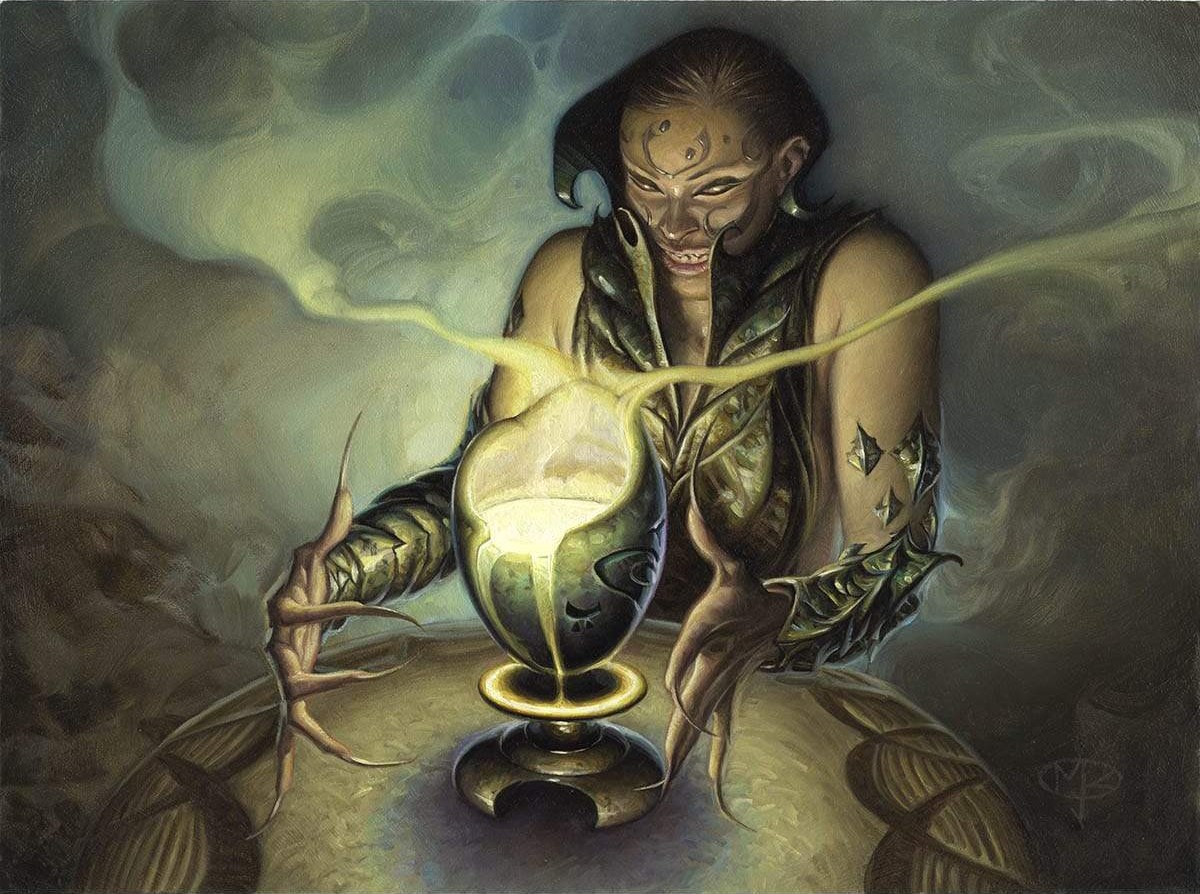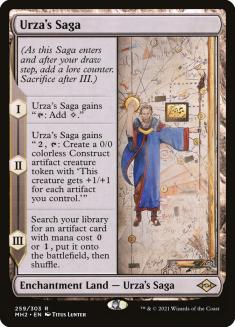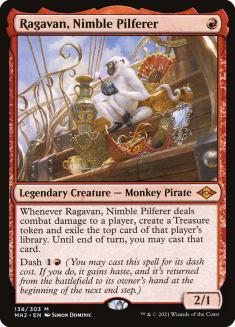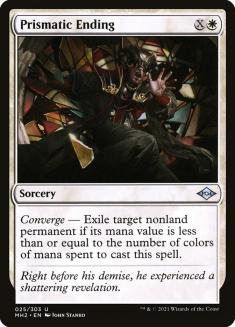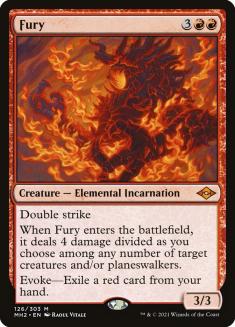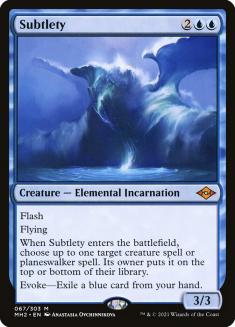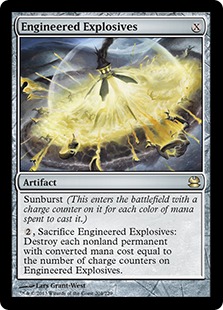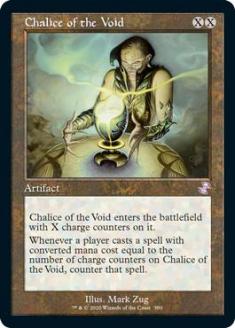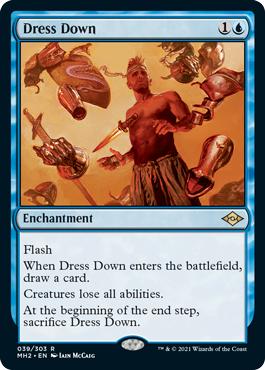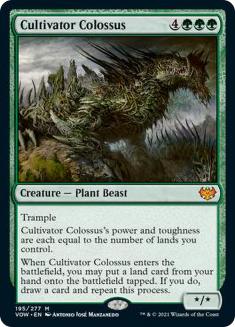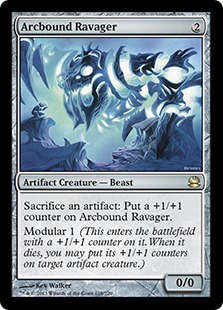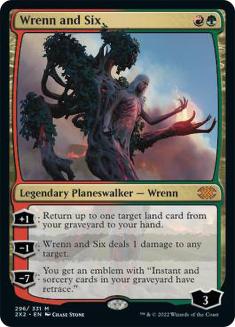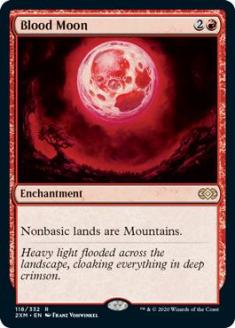As it often does, it feels like Modern took a sharp turn in the last couple of weeks. If you haven’t been poring over lists and battling matches on almost a daily basis, you might feel a bit lost when you jump back in. Things have shifted so far, so quickly, that we have almost moved past the control decks and the wave of anti-control decks.
To help catch everyone up, it’s best to look to the staples of Modern. The defining aspect of post-Modern Horizons 2 Modern feels like a cluster of twenty or so generically good cards that show up across a ton of shells. Having a good deck for each week typically starts with figuring out which of these cards are the best-positioned, and then building the other half of your deck to do something good that supports them and dodges any other best cards that are being overplayed.
So, which staples are the hottest cards on their way up to the top of the standings? And which ones are cooling off and will be the things losing in the early rounds?
Urza’s Saga
With the drop-off in cascade decks solidly cemented in the last couple weeks, Urza’s Saga has been having a comeback tour. Like I said when outlining the most important cards in the format, Urza’s Saga’s and Force of Vigor’s fates in the format are tightly paired. The cascade decks were the most prominent Force of Vigor decks, and without them at the top of the metagame, Urza’s Saga has had a chance to shine again.
But that is going to rapidly change. Other decks like Golgari Yawgmoth, Amulet Titan, and Sultai Infect are great places for Force of Vigor to show up. If control really drops out of the top tier, Living End and Temur Crashcade can come right back. Other great answers to Urza’s Saga exist in the format and those cards are getting better-positioned. And there was another key card that started pushing Urza’s Saga out of the metagame that’s looking better than ever.
Get the most of Urza’s Saga’s good run while it lasts. Honestly, it might even be over by the time this gets posted.
Verdict: Too Hot, Cooling Off Soon
Ragavan, Nimble Pilferer
I’ve spent the last week playing all the nonsense in the format, and there’s a common thread. Turn 1 Ragavan is a problem.
The first category of “Ragavan is a problem” decks are the ones that just can’t kill it. Or maybe they can try to contest it on the play, but on the draw are starting off 40% in the hole against the Monkey. The thing we have learned over the last few months of Ragavan is that it honestly doesn’t even matter if you flip something to cast with the card. That’s just gravy. The good Ragavan decks are built in a way where that Treasure a turn spirals into a much larger advantage. The prime example of this is Gruul Belcher (Kaheera), where Ragavan represents pressure and the ability for Izzet Midrange to make progress while leaving up Counterspell mana.
The second category of “Ragavan is a problem” decks are the ones that can kill it, but aren’t the in business of going head-to-head with Ragavan decks in attrition games. You know the old adage to never mulligan functional hands against Jund Midrange (Lurrus) because all their Thoughtseizes and removal turn your hand to mush anyways? It’s not quite that bad against Izzet Midrange or Rakdos Midrange (Lurrus), but the game where both players trade a card on Turn 1 favors the Lurrus plus Thoughtseize or Expressive Iteration plus Counterspell deck. And unlike the usual case of them Lightning Bolting your good one-drop, the upside of the exchange not happening is all on the Ragavan player’s side.
Add to all this the history of Ragavan being the card that first pushed the non-Colossus Hammer Urza’s Saga decks out of the metagame, and it looks like peak Monkey hours right now.
Ragavan had been trending down for a while after being the best thing in Modern, and now its stock is rapidly rising back to its peak from the pre-Azorius days.
Verdict: Hottest Card in the Format
Prismatic Ending
On one level, Prismatic Ending is worse against a wider metagame. Wider metagames have more room for weirdo expensive cards, and while you’re legally allowed to Prismatic Ending a Cultivator Colossus, you probably won’t like the outcome.
But it’s vital to have catch-all answers in a format where you can literally catch it all with it. Just don’t rely on Prismatic Ending as your only answer, or play it in a deck that ignores expensive cards by being proactive. The card was great before, and it’s still great with no signs of slowing down.
Verdict: Heating Up
The Mythic Elemental Incarnations
I’m taking a lesson from playing Merfolk here.
Solitude is a really powerful card, but it puts you down a card to use early on. It’s great against decks with a limited supply of threats or one specific thing you need to handle, but if your opponents just have a million things you need to kill and deploy them quickly, Solitude is not making profitable trades.
Solitude still has a lot of good spots in the metagame. It’s absolutely dominating against Amulet Titan. There’s a bunch of the notoriously threat-light Izzet Midrange. But there are also lots of decks where Solitude is going to strain your resources. The card is good, but it isn’t the Ragavan-price level great we saw a few weeks ago.
Verdict: Cooling Off
I’m quickly stopping by Fury to mention it does not have the same concerns as Solitude. Against the decks with tons of threats, Fury often gets to trade at card parity. Sometimes four damage isn’t enough to trade, but Fury as a 3/3 with double strike is often an acceptably fast clock if you can interact with those decks or land it a bit early. The card isn’t getting better; it’s just as good as it was before.
Verdict: Holding Steady
Creatures (21)
- 4 Seasoned Pyromancer
- 2 Kroxa, Titan of Death's Hunger
- 4 Grief
- 4 Ragavan, Nimble Pilferer
- 3 Dauthi Voidwalker
- 4 Fury
Lands (16)
Spells (23)

Grief underperformed in early Modern Horizons 2 Modern due to a heavy focus on interactive Ragavan decks and Urza’s Saga as a primary threat. We’re circling around to decks that care a lot more about not having their cards. Urza’s Saga is still around, but often in the context that the decks relying on it are doing something much less impressive when that is what they are forced to do.
Verdict: Heating Up
Endurance is really good as a hedge between hard and soft graveyard hate. It’s a full clear against something like Dredge, which is usually worthwhile a decent amount of time, but against the Dragon’s Rage Channeler decks a 3/4 reach that resets their graveyard is also great.
But Dragon’s Rage Channeler no longer has a monopoly on the fair sector of the metagame the way it did a couple of months ago, and it feels like a different card is the graveyard hate you want now. I don’t quite know what you should be looking for, but there are lots of decks like Azorius Urza (Yorion) and Hardened Scales (Lurrus) where a different form of still flexible graveyard interaction actually stops their modular triggers or Sword of the Meek where Endurance is blank against them.
Endurance is still the right graveyard hate card for some decks, but its stock as a generic good card you can maindeck is on the way down.
Verdict: Cooling Off
I feel obligated to chime in on Subtlety as a member of this cycle, but I shouldn’t be doing it because this article is about generic good cards. Subtlety is the kind of card you play for a very specific reason, like when your Living End deck needs more free answers to Endurance or when you’re working with the “all blue, all creatures” stipulation on Merfolk. Play it if you really should. Don’t try to make it happen if you shouldn’t.
Verdict: Whatever
Counterspell
Cavern of Souls. Aether Vial. Urza’s Saga. Three cards trending up in play that are pretty problematic for Counterspell when you’re trying to trade for your opponent’s threats. Counterspell is still pretty darn good at trading for cardboard, but it isn’t the same degree of warm and fuzzy safety you had with the card previously.
That said, when the warm fuzzy feeling comes when you Counterspell their Chalice of the Void, or their Solitude on your Murktide Regent, or their Counterspell, that’s a whole different ballgame. Then your Counterspell is always going to hit something relevant, and most of the issues I listed for the card can be mitigated by firing off on another lead-up play and just crushing your opponent with real threats instead of waiting around for the inevitable uncounterable bomb to land.
The problem with this for a while was the huge presence of Teferi, Time Raveler in the format. If your control opponent sticking Teferi meant they freerolled any Counterspells you drew, that forced you to sit around with mana up early to Counterspell Teferi, and then you were locked into the reactive long games that favored the bigger control deck. With Azorius and Four-Color Control dropping from “top deck in the format” to “a deck in the format,” that goes from a defining line up in the format to simply one possible line-up in the format. And Counterspell goes from a card you might play to one of the best answer-slash-protection-spells your deck can show up with.’
Verdict: Cooling Off in control decks, Heating Up in proactive decks
Teferi, Time Raveler
The continuing narrative of this article has been Azorius Control and Four-Color Midrange being on a downward trend. That hasn’t changed. Many of the issues I had with Solitude also apply to Teferi, where it just isn’t a good card against decks playing a bunch of individual threats early on.
But you probably should consider Teferi, Time Raveler for the sideboards of your less controlling decks. There is a window between things getting weirder and punishing control, but decks also not making as many concessions to Teferi as they may have in the past. The Pact of Negation count in Gruul Belcher (Kaheera) is a pretty big example of this. In something like the white-splash versions of Izzet Midrange, Teferi would be on the list of sideboard cards I consider, and the less worried about mana efficiency my deck is, the more I would be trying to slot in.
Verdict: Heating Up, as a sideboard card
Engineered Explosives
There are lots of reasons to play Engineered Explosives in Modern. The ability to cover Construct tokens or whatever nonsense permanent your opponent is playing with makes it a pretty nice card in the short-term uptick in Urza’s Saga decks.
But in the medium term, I think Engineered Explosives could be a bit of a trap. As much as I like the card against most Urza’s Saga decks, I hate it against most Dragon’s Rage Channeler and Ragavan decks. It has horrible mana efficiency trading for a single one-drop threat, and the dream of killing multiple threats usually gets ruined by you dying to those threats instead. You’re telling me they connected with Ragavan or untapped with Dragon’s Rage Channeler, extended another threat that wasn’t a Tarmogoyf or Murktide Regent, didn’t have an Inquisition of Kozilek or Thoughtseize? And then you, what, end up ahead a single card that Lurrus or Expressive Iteration immediately undoes?
Pop some Engineered Explosives in your deck for now, but don’t get stuck with them in your sideboard for too long.
Verdict: Heating Up, but uncertain future
Chalice of the Void
The Cascade- and Ragavan-crushing heyday of Chalice of the Void in Modern from a couple of months ago is over. Even if Ragavan is on its way back, the metagame is more split between Izzet Midrange and Grixis Death’s Shadow (Lurrus) that have bigger issues with Chalice and the Rakdos variants that often punish Chalice with Kolaghan’s Command. But that doesn’t mean Chalice doesn’t incidentally pick up value against a variety of other decks.
I’m not going out of my way to play any Chalice of the Void right now, but if the metagame starts swinging back to the point it’s a reasonable sideboard card, I think you would be best off making a fast move in that direction. There’s just some nice incidental value to be picked up in a lot of spots with it. This is all in small quantities and not even consistent deck to deck, like the times you have better things to do against Amulet Titan than shut off their Summoner’s Pacts, but you will get 10% bonus value against the field on top of whatever primary reason you are playing Chalice.
Creatures (21)
- 4 Arcbound Ravager
- 2 Arcbound Worker
- 4 Hangarback Walker
- 4 Walking Ballista
- 4 Zabaz, the Glimmerwasp
- 3 Ingenious Smith
Lands (25)
Spells (14)

Note this only really applies if you are able to cast Chalice of the Void for X = 1. The Chalices for ones in the sideboard of Hardened Scales (Lurrus) felt pretty terrible when they shut off as many of your cards as your opponent’s.
Verdict: Cooling Off, but less than you think
Dress Down
Dress Down was a solid metagame choice a couple of weeks ago when Corey Baumeister won the SCG Invitational with Grixis Death’s Shadow (Lurrus). It has only gotten better since then.
Since then we have seen a surge in cards that get hard-countered by the enchantment. That’s not to mention all the things it handles without killing in ways that avoid traditional counterplay to answers: a Primeval Titan regardless of Amulet of Vigor status, a Thassa’s Oracle post-Spoils of the Vault, a giant Blighted Agent. Oh, and Construct tokens, because the tempo of negating multiple turns of activating Urza’s Saga is usually game-ending.
It’s tough to play a ton of Dress Down because the card really does nothing on its own, but even if it’s just the ability to cast the card on their end step and bounce it with your Teferi, Time Raveler for a bonus card it feels really easy to sneak the first copy or two into your deck to great effect.
Creatures (13)
Lands (18)
Spells (29)

It’s easy to have your eyes glaze over when you see Izzet Midrange decklists, but the fact that running multiple copies of Dress Down in the sideboard of that deck is basically stock right now should be telling.
Verdict: Heating Up
Wrenn and Six
Wrenn and Six is really good at exactly three things: making sketchy fetchland mana work, removing one-toughness creatures, and being an early threat in interactive mirrors that keeps up card parity if removed.
Ragavan is amazing, but even if it’s pushing that way, it isn’t the metagame king the way it was before. Your opponents are going to be less interactive, so Wrenn getting to seven loyalty and an emblem isn’t as pressing of a threat. The card is good, but it won’t perform to the peaks it was at a few weeks ago.
Running the full four Wrenn and Six in your deck is far from sacred, unless it’s for the Four-Color pile fixing, and even then I’m dubious that adding the extra colors largely for Wrenn is getting you more than playing something else. I have similar feelings about Jund Midrange (Lurrus) versus the other Rakdos-based Lurrus decks, and the drop-off in Wrenn and Six’s metagame power points me towards Grixis Death’s Shadow (Lurrus) or Rakdos Midrange (Lurrus) as the sub-archetype of choice there.
Verdict: Cooling Off
Blood Moon
Blood Moon is good against Amulet Titan. Congrats. You figured the one thing out, and yes, this props it ahead of Alpine Moon right now. Honestly, it isn’t even that good compared to the pre-Force of Vigor, pre-five Forest era you might have benchmarked it against.
What else are you really excited to cast Blood Moon against? It’s fine on the play in a few spots, but there are fewer Four-Color piles, basically no Urza’s Tower, and Ragavan is on the way back up. I wouldn’t call Blood Moon completely unimportant in Modern right now, but it was on its way back to being a maindeck card and now feels solidly relegated to a couple of sideboard slots at best.
I’m not even sure this deck should be playing four maindeck Blood Moon, and that’s saying something. Having functional Den of the Bugbear is honestly just better most games.
But literally a single shift in the metagame quickly wraps Blood Moon back around to being amazing. It feels like every Wednesday every Modern player needs to ask themselves if this is a Blood Moon week, and plan accordingly if it is.
Verdict: Cooling Off, but heats up quickly when it gets good
Honestly, you should probably be doing that for each of these staples. If Modern is going to be a format about a bunch of really powerful, really flexible cards, you would do best to start thinking about it that way from the top down.

